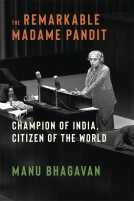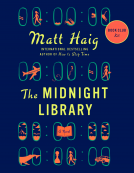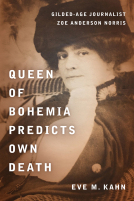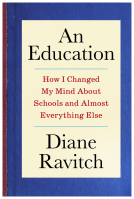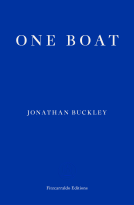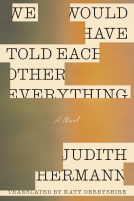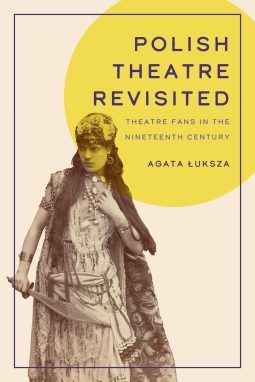
Polish Theatre Revisited
Theatre Fans in the Nineteenth Century
by Agata Luksza
This title was previously available on NetGalley and is now archived.
Send NetGalley books directly to your Kindle or Kindle app
1
To read on a Kindle or Kindle app, please add kindle@netgalley.com as an approved email address to receive files in your Amazon account. Click here for step-by-step instructions.
2
Also find your Kindle email address within your Amazon account, and enter it here.
Pub Date Jan 19 2024 | Archive Date Jan 19 2024
University of Iowa Press | University Of Iowa Press
Talking about this book? Use #PolishTheatreRevisited #NetGalley. More hashtag tips!
Description
THEATRE / SCHOLARLY
Polish Theatre Revisited explores nineteenth-century Polish theatre through the lens of theatre audiences. Agata Łuksza places special emphasis on the most engaged spectators, known as “theatremaniacs”—from what they wore, to what they bought, to what they ate. Her source material is elusive ephemera from fans’ lives, such as notes scribbled on a weekly list of shows in the Warsaw theatres, collections of theatre postcards, and recipes for sweets named after famous actors.
The fannish behavior of theatremaniacs was usually deemed excessive or in poor taste by people in positions of power, as it clashed with the ongoing embourgeoisement of the theatre and the disciplining of audiences. Nevertheless, the theatre was one of the key areas where early fan cultures emerged, and theatremaniacs indulged in diverse fan practices in opposition to the forces reforming the theatre and its spectatorship.
Advance Praise
“A brilliant example of how theatre is not only a national history repository, but of how the conversations across the footlights between actors and audiences can be highly provocative, political, and empathetic concurrently. Łuksza’s vivid descriptions of nineteenth-century Polish theatremania celebrate and apotheosize fan and actor practices in this long overdue, illuminating book.”—Caroline Heim, author, Audience as Performer: The Changing Role of Theatre Audiences in the Twenty-first Century
“The future of fan studies lies in new historical and cross-cultural scholarship; and here, Łuksza boldly offers both. Through imaginative research, Łuksza excavates hidden elements of nineteenth-century Polish theatre life, shaped by charismatic stars, rival audiences, and resistance politics, establishing Warsaw’s ‘theatremaniacs’ as a definitive example of historical fandom.”—Daniel Cavicchi, author, Listening and Longing: Music Lovers in the Age of Barnum
Available Editions
| EDITION | Other Format |
| ISBN | 9781609389291 |
| PRICE | $100.00 (USD) |
| PAGES | 350 |
Links
Available on NetGalley
Average rating from 3 members
Featured Reviews
 Willy M, Reviewer
Willy M, Reviewer
This is a slice of life. "Polish Theatre Revisited" takes you to the time and place of 19th century and early 20th century Polish theatre and gives you more than enough joy at the development of the Polish theatre. I can't express enough how joyful it was to just get caught up in this book. It really is a time machine for immersing yourself in the fads, fancies and frolics of the day. It is also very serious in that it gives in English a wonderful description that can't be found elsewhere of the development of a pivotal artform in Polish culture.
 Reviewer 762493
Reviewer 762493
"Polish Theatre Revisited: Theatre Fans in the Nineteenth Century" took me a long time to read, because I kept stopping to look up Polish history, Polish actresses, Sarah Bernhardt, Polish pronunciations and more - every detail Agata Luksza mentions seems fascinating and worth looking into.
The book (appropriately) starts with a chapter on Polish nationalism and the theater, framing theater as a space for Polishness under the Russian occupation, while also offering historical context not only regarding 19th century Poland, but also regarding the approach to studying the history of Polish theater as a "serious" endeavor (hint: the 19th c. is interpreted in a national key).
We start, then, with the mainstream, but then we move on to the more marginal "fannish" experiences. First, we have male fans of ingenue actresses having symbolic fights over the objects of their affections (Wisnowska vs. Czaki) while behaving in a manner that other theater-goers perceived as disruptive and childish. Their fights, while frowned upon, make the newspapers.
Another chapter discusses the Warsaw theater-goers' passion for (and women's emulation of) Sarah Bernhardt, the Jewish-French actress; emulating her was, naturally, frowned upon. But it still made the news, if only as mockery.
Then we have women fan circles and their passion for actresses and for collecting photographs and memorabilia. Already, this is turning into a secret history of sort, the kind that's hard to track and understand.
And finally, the vogue for Japan, Japanese-themed shows, and Japanese objects, vaguer than the rest, because the objects of interest are fashions and styles derived from an Orientalist view borrowed from the English, rather than an abiding love for celebrities or causes that strike close to home. If the previous chapters can name specific fans and their behaviors, this one is more general.
As I've said, I stopped often to look up things. Agata Luksza includes some images in her book, especially when discussing important photographs or paintings, but I still fell down the rabbit hole of looking for the actresses who fascinated crowds over a century ago. I found Judwiga Czaki beautiful, and Maria Wisnowska fascinatingly ugly (interestingly, Luksza seems more of a Wisnowska fan - we'd be on opposite sides of the barricade here!). Sarah Bernhardt I couldn't really get a feel for through photos alone. I looked up maps of split Poland, and tried to find images of theaters.
But even without my endless searches, Luksza's book stands on its own (although perhaps looking up Poland's 19th c. history in the broadest terms doesn't hurt), recreating a lost world of finding entertainment, meaning and freedom in the theater, and taking the chance at the start of every chapter to create an illustration of what life might have been like for theatre-goers of the type she'll describe. It's a lovely volume, and one that came as a very pleasant surprise.
 Mandy J, Reviewer
Mandy J, Reviewer
This was quite a heavy read, as it’s an academic text, but the writing is accessible and if you’re someone who’s interested in the history of theatre, its stars and its fans, then this is a must-read. I knew nothing about Polish theatre before embarking on it, and I learnt a great deal, especially about the rise of “fandom” there, and “fans” really hasn’t changed much over the years - although now perhaps more visible in the music world. Although the focus is on Polish theatre, the book nevertheless has a universal relevance for theatre lovers and students and I think most readers will find much of interest here. I certainly did.
Readers who liked this book also liked:
Rachel Joyce
Historical Fiction, Literary Fiction, Women's Fiction
We Are Bookish
Biographies & Memoirs, Health, Mind & Body, Nonfiction (Adult)

